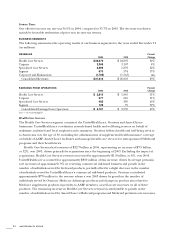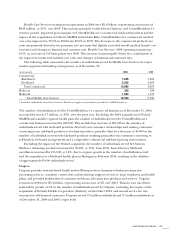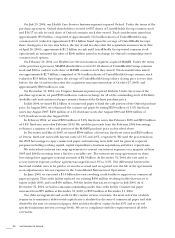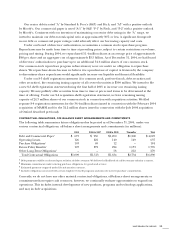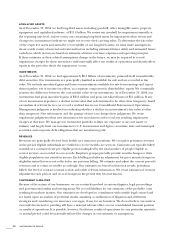United Healthcare 2004 Annual Report Download - page 36
Download and view the complete annual report
Please find page 36 of the 2004 United Healthcare annual report below. You can navigate through the pages in the report by either clicking on the pages listed below, or by using the keyword search tool below to find specific information within the annual report.
34 UNITEDHEALTH GROUP
AARP
In January 1998, we entered into a 10-year contract to provide health insurance products and services
to members of AARP. These products and services are provided to supplement benefits covered under
traditional Medicare. Under the terms of the contract, we are compensated for transaction processing
and other services as well as for assuming underwriting risk. We are also engaged in product development
activities to complement the insurance offerings under this program. Premium revenues from our
portion of the AARP insurance offerings were approximately $4.5 billion in 2004, $4.1 billion in 2003
and $3.7 billion in 2002.
The underwriting gains or losses related to the AARP business are directly recorded as an increase
or decrease to a rate stabilization fund (RSF). The primary components of the underwriting results are
premium revenue, medical costs, investment income, administrative expenses, member services expenses,
marketing expenses and premium taxes. Underwriting gains and losses are recorded as an increase
or decrease to the RSF and accrue to the overall benefit of the AARP policyholders, unless cumulative
net losses were to exceed the balance in the RSF. To the extent underwriting losses exceed the balance in
the RSF, we would have to fund the deficit. Any deficit we fund could be recovered by underwriting gains
in future periods of the contract. To date, we have not been required to fund any underwriting deficits.
As further described in Note 11 to the consolidated financial statements, the RSF balance is reported in
Other Policy Liabilities in the accompanying Consolidated Balance Sheets. We believe the RSF balance
is sufficient to cover potential future underwriting or other risks associated with the contract.
Regulatory Capital and Dividend Restrictions
We conduct a significant portion of our operations through companies that are subject to standards
established by the National Association of Insurance Commissioners (NAIC). These standards, among
other things, require these subsidiaries to maintain specified levels of statutory capital, as defined by each
state, and restrict the timing and amount of dividends and other distributions that may be paid to their
parent companies. Generally, the amount of dividend distributions that may be paid by a regulated
subsidiary, without prior approval by state regulatory authorities, is limited based on the entity’s level of
statutory net income and statutory capital and surplus. The agencies that assess our creditworthiness also
consider capital adequacy levels when establishing our debt ratings. Consistent with our intent to maintain
our senior debt ratings in the “A” range, we maintain an aggregate statutory capital level for our regulated
subsidiaries that is significantly higher than the minimum level regulators require. As of December 31, 2004,
our regulated subsidiaries had aggregate statutory capital of approximately $4.1 billion, which is significantly
more than the aggregate minimum regulatory requirements.
Critical Accounting Policies and Estimates
Critical accounting policies are those policies that require management to make the most challenging,
subjective or complex judgments, often because they must estimate the effects of matters that are
inherently uncertain and may change in subsequent periods. Critical accounting policies involve
judgments and uncertainties that are sufficiently sensitive to result in materially different results under
different assumptions and conditions. We believe our most critical accounting policies are those described
below. For a detailed discussion of these and other accounting policies, see Note 2 to the consolidated
financial statements.


